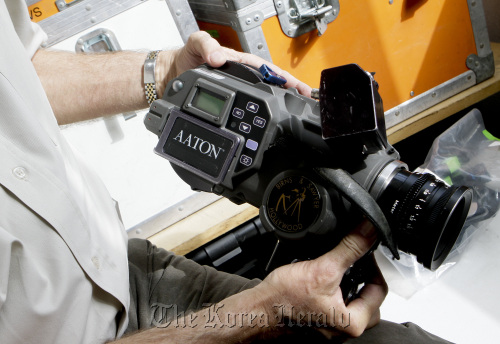LOS ANGELES ― Call it film’s last gasp.
Birns & Sawyer, the oldest movie camera rental shop in Hollywood, made history last week when it auctioned off its entire remaining inventory of 16- and 35-millimeter film cameras.
Owner and cinematographer Bill Meurer said he didn’t want to part with the cameras but had little choice as the entertainment industry has largely gone digital.
“People aren’t renting out film cameras in sufficient numbers to justify retaining them,” Meurer said in an interview at his North Hollywood warehouse, where he rents out cameras, lenses, lighting equipment and grip trucks.
“Initially I felt nostalgic, but 95 percent of our business is digital. We’re responding to the market.”
 |
This Aaton A-minima super 16mm film camera was sold during an online auction in North Hollywood, California, on Oct. 20. (Los Angeles Times/MCT) |
The auction underscores just how rapidly Hollywood is transitioning to digital. Theater chains are increasingly converting their multiplexes to digital projectors because studios are soon expected to stop releasing film prints altogether. And major camera manufacturers such as Arri and Panavision have for now halted production of new film cameras (although they are still doing upgrades on film equipment).
Today, virtually all television production and about one-third of all feature films are being shot digitally.
The auction at Birns & Sawyer marks another milestone because the shop has been a fixture in Hollywood since its founding in 1954 by Life photographer and war correspondent Jack Birns and fellow Korean War veteran Cliff Sawyer. Within a few years, it began renting equipment used on such movies as “Lawrence of Arabia,” “Easy Rider” and the Steve McQueen classic “Bullitt.”
Meurer, a former cinematographer and gaffer, acquired Birns & Sawyer in 1998, merging it with his lighting and camera rental business.
Like other camera equipment suppliers such as Panavision, Birns was hard hit by the sharp falloff in demand for film cameras and equipment.
The shift to digital accelerated rapidly in 2008 when labor unrest within the Screen Actors Guild prompted a number of producers to sign deals with its sister union, the American Federation of Television & Radio Artists. AFTRA traditionally represented shows shot on video rather than film.
Company sales have plummeted to $5 million from a peak of about $10 million a year in 2006, Meurer said. To cut costs, Birns & Sawyer consolidated its operations, leaving a second 9,000-square-foot office space it had leased in Hollywood.
Still, unlike other service providers that have fallen by the wayside, Birns & Sawyer has survived by adapting. It was among the first camera rental houses to offer digital video cameras from Sony and Panasonic in 2000. The company also manufactures camera shoulder supports, matte boxes, lens mounts and other products that have helped to diversify its business.
In last week’s auction, Meurer sold 15 film cameras _ used on such movies as “Anaconda,” “Silver City” and the original “X-Men” ― to other cinematographers and camera houses. The equipment sold for $225,000 ― only about a quarter of its original value.
But Meurer said he was happy with the outcome, adding that proceeds will help his company complete its digital transition.
“It was a little bit upsetting for some of the employees with the prestige of losing our film cameras,” he said. “But it gives us the ability to buy all these new 35-millimeter lenses that can be used for digital cameras.”
By Richard Verrier
(Los Angeles Times)








